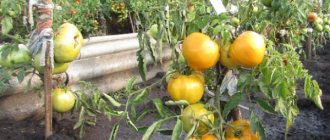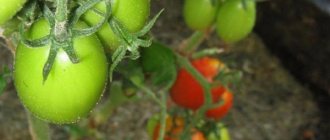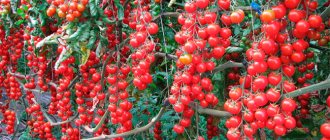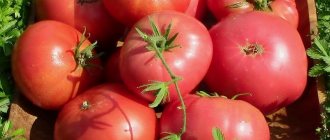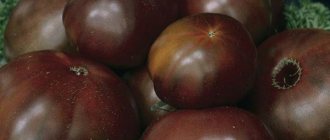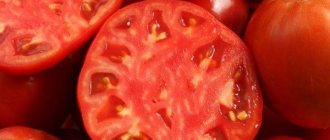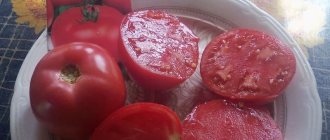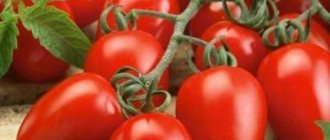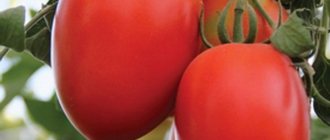The Sergeant Pepper tomato variety is one of the new products in the field of agricultural cultivation. The variety was recently released in America. In Russia it is not very widespread due to its novelty, but its cultivation is rapidly gaining momentum.
This tomato variety is a spectacular, bright fruit with a sweet taste. Most often used for preparing salads, baking, stewing. Suitable for tomato juice, puree, paste, preparations.
In addition to those beneficial substances inherent in ordinary tomatoes, “Sergeant” contains a large amount of anthocyanin, the determining element of interesting coloring. The element is responsible for the functioning of the visual organs and can even stop glaucoma. Anthocyanin is a powerful antioxidant, prevents diseases, and strengthens the immune system.
Characteristics and description of the tomato variety Sergeant Pepper
The hybrid was bred by breeder James Hanson from America. As a result of crossing the Blue and Red strawberry varieties. The resulting hybrid is considered indeterminate, since it does not have an endpoint of growth. Sergeant Pepper bushes reach 2 m. They are grown mainly on trellises. The bush at the genetic level turned out to be semi-standard, slightly branched, and compact. All the power of the plant is directed towards the growth and ripening of tomatoes.
Sergeant Pepper shoots are flexible and brittle, so they must be tied to supports. Painted light green. Leaf cover is sparse. The plate is dark green, slightly curved at the edges, rough.
The flowers of the hybrid Sergeant Pepper are a rich dark color. They do not require pollination. The formation of the ovary is good - up to 98%. The first flower cluster is formed after the 4th leaf, the subsequent ones - every two. Each fruiting branch contains from 4 to 6 tomatoes. Their color is rich.
The originator claims that the Sergeant Pepper hybrid is a mid-early tomato. The first harvest is collected on the 120th day after planting in the ground. Fruiting is wavy, long. From the first half of August until September you can enjoy fresh tomatoes.
A distinctive feature of the Sergeant Pepper variety is the ability of tomatoes to ripen. The last harvest is harvested at the stage of technical ripeness, which does not prevent them from singing in storage.
Hybrid Sergeant Pepper is represented by Blue and Pink Heart tomatoes. The fruits have similar characteristics. They are distinguished only by the color of their skin. The shape of the tomato is round at the top, narrows downwards and becomes heart-shaped. The upper part is dark in color, which reaches the middle of the fruit. At the moment of ripeness it acquires a purple hue. The main color of a tomato depends on the variety.
The tomato peel is thin and can crack if transported carelessly. Looks smooth and shiny. In cross-section, the tomatoes are four-chambered. The flesh is a rich burgundy color, juicy, sweet, dense. There are few seeds.
Description and characteristics of the variety
This tomato is also known as Sgt Pepper s tomato. It has an indeterminate type of bushes that reach 2 meters. The leaves are ordinary. The fruits ripen in medium terms; they grow in clusters of 6-8 pieces. They are heart-shaped, bright red with dark purple “shoulders.” Inside the flesh is red-crimson. The weight of tomatoes is 150-200 g, sometimes individual specimens reach 300 g. The taste is very sweet with a caramel tint.
The fruits of the variety contain anthocyanin, which has a beneficial effect on vision, fights glaucoma, is an antioxidant and helps in the prevention of diseases.
Pros and cons of the Sergeant Pepper tomato variety
The main advantage of Sergeant Pepper blue and pink tomatoes is their productivity. With proper care, bushes give good performance. In addition, they are compact and can be grown in crowded plantings. For 1 sq. m 4-5 plants are allowed. The hybrid rarely gets sick; in greenhouses and in open ground it resists typical diseases well.
The disadvantages of tomatoes include:
- low frost resistance;
- demands on lighting;
- poor drought resistance.
The bushes do not tolerate the vagaries of the weather at all; when the temperature drops, they need to be covered at night. That is why in most regions of the Russian Federation the crop is grown in greenhouses. You need to plant in a well-lit place, since the slightest darkening is detrimental to these tomatoes. Sergeant Pepper bears full fruit only with sufficient light and warmth. Immediately after planting the seedlings, you need to organize regular watering, since the hybrid is picky about the lack of moisture at the roots. May shed ovaries.
Brief information about the variety
- Fruits and bush : exotic tomatoes weighing up to 200 g, growing on an indeterminate bush two meters high.
- Productivity : 4 kg per bush.
- Resistance : good cold resistance and immunity to late blight have been recorded.
- Distribution : southern regions are recommended (planting in open ground), in the north only greenhouse cultivation.
- Application : suitable for salads, canning, freezing, processing into ketchups, juices, pastes.
- Planting : seedling method only.
- Soil : predominantly light, “not greasy” soils.
- Care : standard agricultural technology, minimum pinching; due to the fragility of the shoots, it is advisable to grow in two stems.
- Ripening period : fruiting from mid-summer to mid-autumn.
Optimal growing conditions
For planting Sergeant Pepper tomatoes, you need to take the lightest bed, which will be reliably sheltered from drafts and cold winds. In order for them to ripen, they need to create suitable conditions. The temperature in the greenhouse is maintained at a high level, especially in the spring after planting seedlings. If there is no heating in it, then it is recommended to cover the plants with agrofibre at night.
The soil for planting must be pre-fertilized. This can be done in the fall or spring. Rotted organic matter and mineral fertilizers are added during digging. The holes are filled with fertile soil before planting.
Advantages and disadvantages of the variety
The main features and basic positive differences of Sergeant Pepper are:
- delightfully unique colors, amazing fruit exterior;
- delicate caramel sweetness and tart aroma of fruits;
- immunity to diseases and hostile bio-forms;
The disadvantages of a hybrid include:
- low ripening on the bush;
- difficulty of acquisition (private collections only, preferably different seed suppliers);
- poor shelf life, poor transportability.
Growing
Pepper tomatoes are grown in seedlings on the territory of the Russian Federation. They start planting at the end of March or at the very beginning of April, so that the plants do not stretch out from lack of light. Ready seedlings at the age of 45-50 days are transferred to the garden bed.
Growing seedlings
There is nothing difficult when growing Sergeant Pepper seedlings. The plants are not much different from other varieties. Planting containers are filled with nutrient substrate, watered abundantly and the seeds are laid out.
Important! Sergeant Pepper seeds remain viable for 3 years.
The first shoots are noticeable after 5-7 days. At the 2-3 leaf stage, the plants are planted into separate cups. If they were immediately planted in such containers, then all you have to do is thin them out. Weak sprouts are removed.
A week after picking, the seedlings are fed with complex mineral fertilizer. The concentration of the infusion is reduced by 2 times from that indicated on the package.
Landing rules
Hardened seedlings are transferred to the garden bed in the first ten days of May. Planting holes are made 10-15 cm deep, after which plants are installed obliquely in them. You need to fall asleep before the first leaves. After planting, the holes are watered and mulched to retain moisture.
If you plan to plant in unprotected soil, then it should be done no earlier than the soil warms up to a temperature of +18°C.
Watering and fertilizing
The Sergeant Pepper variety is demanding when it comes to watering. The soil under the bushes should always remain moist, so it is better to organize a drip system. If this is not possible, then you need to moisten the soil as it dries. During the dry period, water once every 2-3 days. You can avoid soil crust on the ground, which does not allow oxygen to reach the bushes, by mulching.
Attention! The root system of the Sergeant Pepper tomato hybrid is very weak and superficial. Without fertilizing, it will not be possible to reap a good harvest.
The hybrid is fed every 2 weeks after the tomatoes have taken root in the garden. Organic matter is alternated with mineral fertilizers. Phosphorus-potassium mixtures and superphosphate are used.
Pinching and tying
As already mentioned, you need to grow the Sergeant Pepper hybrid on supports. As they grow, the stems are tied up so that they do not break off under the weight of the fruit.
The peculiarity of the variety is that the bushes need to be regularly pruned to increase yield. In addition to the stepsons, all lower leaves and spawning brushes are cut out.
Formation
Some gardeners grow Sergeant Pepper tomatoes with 3-4 stems. Although the originator states that it is best to form the plant into 1-2 stems. All unnecessary stepsons are removed. This will only increase the yield.
Protection from diseases and pests
Although the hybrid is highly resistant to diseases, in greenhouses it can be affected by tobacco mosaic and cladosporiosis. The most common pest found on bushes is Colorado potato beetles.
The hybrid does not need spraying, but for preventive purposes it is treated with copper-containing preparations in early spring after planting in the ground.
general characteristics
Sergeant Pepper tomatoes are mid-ripening plants.
The bush is poorly leafy, fragile in seedlings and commercial cultivation (it is better to form two stems). The stem reaches a height of 2 meters.
The fruits are elongated in cross section and resemble a heart. The weight of individual copies is 200 g.
The fleshy pulp of the variety is famous for its juicy caramel taste and pleasant aftertaste.
The calling card of this variety is the memorable, extraordinary color of the fruit - it is deep red with blue-violet hues.
Purple color is the coloring pigment anthocyanin, which (being a strong antioxidant), in addition to exclusive toning, gives tomatoes medicinal and prophylactic properties.
Productivity
The productivity of tomatoes depends not only on the variety, but also on a series of accompanying factors: climatic features, soil fertility and agrotechnical tactics.
The American breeder does not position his development as an industrial high-yielding variety. Sergeant Pepper are collectible tomatoes; although they are tasty, they are created more for the delight of the soul and the decoration of the beds.
Domestic vegetable growers who practice the variety claim 5-10 fruits per cluster, and a total yield of 4 kg per plant per season.
Application area
The main purpose of the variety is country cooking.
Exquisite tomato beauties, of course, can be canned (salted and pickled), processed into juices, pastes, and sauces.
But it's best to eat them fresh. The taste is simply amazing.
Resistance to diseases and pests
Foreign selection declares the variety as a crop resistant to diseases and pests.
The expert community recommends not to delude yourself and not rely on immunity.
Fungicidal prevention, high-quality fertilizing, and timely response to negative symptoms will help avoid phytodiseases and pest attacks and contribute to high-quality and abundant harvests.
Growing regions
The fruits have an excellent taste
Muddy Bucket Farm owner and breeder Jason Hines has created a versatile variety.
Its characteristics are simple: it will grow well in open ground if there is enough warmth. And in harsh climates it is better to grow under greenhouse film.
Russian summer residents advise cultivating the variety in open ground in the southern regions (the central part and south of the country), and for cultivation “from the Urals to Siberia” you will need greenhouses or tunnel shelters.
():
Indeterminate tomatoes, with a stem height of up to 2 meters, like Sergeant Pepper, cannot be grown in tunnel shelters. Low-growing tomatoes with a maximum height of 50-60 cm are suitable for this.
Productivity
With proper care, Sergeant Pepper tomatoes bear fruit well. The yield is up to 4 kg per bush, as can be seen from the photos and reviews. It is possible to collect up to 13 kg of fruit per unit area.
Yields may decrease if the bed is not positioned correctly, there is insufficient moisture in the soil or poor lighting.
Warning! The amount of harvest does not depend on the growing method. In greenhouses, as in an open garden bed, it remains at the same level.
When growing tomatoes in greenhouses, you can pick the first fruits 2 weeks earlier. But this does not increase productivity.
Main characteristics
The tomato variety Sergeant Pepper is a plant of average frost resistance. In unprotected soil, if there is a threat of return frosts, shelter is required. The plant does not tolerate shade, is light-loving, the taste of the tomato is fully revealed in good light and high temperature. Tomato tolerance to drought is low; the bushes must be watered from the moment of planting until the last fruits are harvested.
Tomatoes, subject to comfortable growing conditions, give a high yield. An incorrectly located bed, a lack of moisture and ultraviolet radiation can reduce the indicator. Under optimal conditions, the yield from 1 unit. is 3.5–4 kg. The plant is quite compact; at least 4 tomatoes are planted per 1 m2, and up to 13 kg are harvested. The variety is mid-early, the first wave of the harvest reaches biological ripeness in the second half of August, fruiting lasts until the first frost. In the greenhouse, ripening occurs 2 weeks earlier. The yield level does not depend on the growing method.
The selective tomato variety Sergeant Pepper has good immunity to most diseases. Tobacco mosaic or cladosporiosis may occur in greenhouses. In greenhouse structures, pests do not attack the plant. In open ground, the plant rarely gets sick, but it can be parasitized by the larvae of the Colorado potato beetle.
Advantages and disadvantages
The Sergeant Pepper tomato is characterized by a number of advantages:
- Good yield indicator.
- Long fruiting period.
- Blue and pink varieties produce fruits with exotic colors.
- The fruits are valued for their chemical composition, which is unusual for conventional varieties.
- Tomatoes for universal use, with a high glucose level.
- The fruits do not lose their varietal characteristics during artificial ripening.
- Suitable for cultivation in greenhouses and open ground.
- The variety resists infections and pests well.
The downside is the requirement for heat, light, and watering. Not everyone likes the complete absence of acid in the taste.
Main advantages and disadvantages
In addition to its exotic appearance, Sergeant Pepper has many other advantages:
- long-term fruiting, right up to the onset of frost (this is true for both the greenhouse and the garden bed);
- ripens well without losing its unique appearance;
- excellent taste, most appreciated fresh and in sauces;
- the skin is thin, but no cracking is observed;
- withstands changeable weather conditions;
- responds favorably to fertilizers;
- high resistance to many tomato diseases.
However, there are a few fly in the ointment of Sergeant Pepper's virtues:
- seeds can only be obtained from private collections, and it is advisable to take them from several sources at once;
- keeping quality is weak;
- In shade, productivity decreases.
Advice. To achieve the most pronounced beauty of the fruit, grow the tomato in a place well lit by the sun. This is how the pigment will fully manifest itself.
Description of the variety
The Sergeant Pepper tomato belongs to the indeterminate varieties, growing on average up to 2 m. To prevent the height of the bush from negatively affecting the quality of the fruit, it is recommended to break off the upper part of the plant at a height of about 1.8 m. The tomato itself is distinguished by a small number of leaves and shoots, so it The growing season is aimed primarily at the formation of fruits.
Appearance of the bush
During the growth process, up to 4 shoots of the first row are formed on the bush. The stems are quite weak and have an average thickness. Pale green shoots may have a brown tint. The leaves are colored rich green. Their surface is slightly corrugated, and large teeth are located on the edges.
The root system of a tomato is superficial. Due to the fact that it grows poorly, the plant requires regular watering and fertilization. On average, 5-6 ovaries are formed on the fruit cluster. Tomato blossoms are represented by yellow flowers. The variety itself is self-pollinating.
As for ripening, the Sergeant Pepper tomato is characterized by medium-early terms. The first harvest can be harvested 120 days after planting the seedlings in a permanent place. The fruiting period will last until mid-September.
Description of fruits
Sergeant Pepper comes in two varieties: blue and pink. Their characteristics are identical, the only difference is the color of the fruit. The tomatoes themselves have the following characteristics:
- Round shape at the stalk and narrowing towards the top. When the fruit is cut, the cross section is shaped like a heart.
- The fruits grow in different sizes. The average weight of one is 180-280 g.
- Tomatoes are distinguished by their bicolor coloring. The upper part of the blue subspecies is dark burgundy in color, and the lower part is purple pigmented with pronounced anthocyanin. The pink subspecies is characterized by pink fruits without a clear anthocyanin effect.
- The skin is quite thin. If there is a lack of moisture, cracks may appear on it.
- The surface of the fruit is smooth.
- The pulp is juicy and quite dense. Combines burgundy and brown colors.
The taste of the fruit is sweet with a slight caramel flavor. At the same time, tomatoes are completely devoid of acid. They are used both for fresh consumption and for preparing canned food, ketchup, pastes and juice.
Frost resistance
Tomatoes of this variety have average frost resistance. If the crop is grown in open ground, then in case of frost it requires shelter. It also does not tolerate shaded areas well. With good lighting and proper care, the taste qualities of these tomatoes are fully revealed.
Productivity
Under favorable conditions, these plants produce maximum yield. From one bush you can harvest up to 4 kg of ripe tomatoes. Its quantity can be reduced by such unfavorable factors as lack of moisture and sunlight, or improper placement of the bed. The method of growing tomatoes can also affect the yield.
Reviews
Ivan, 40 years old:
I have been growing tomatoes for more than 15 years and at the same time I like to experiment with varieties. Last season I tried to grow Sergeant Pepper, whom many recommended to me. Well, what can I say: the yield is average, regular care is required, but the taste of the fruit is simply delicious.
Tatyana, 32 years old:
I love growing unusual varieties of tomatoes. And recently I came across Sergeant Pepper's seedlings. To say that I am delighted with this variety is to say nothing. In addition to their unusual appearance, the fruits have a delicious taste and aroma, and they are also very suitable for preservation and processing.
Maria, 55 years old:
The Sergeant Pepper variety was bought and planted for me by my children, although I was initially against it because I don’t like to experiment. However, I liked the taste of tomatoes. They can also be used to make homemade ketchup and tomato.
Growing tomatoes
Tomato prefers to be grown through seedlings. Direct sowing into the ground is critical: the fruits will not have time to ripen in a short summer.
Sowing seedlings
The timing of sowing seeds is selected depending on regional climatic conditions. For good “forcing” of seedlings, 45 days are needed.
The practice is standard: standard containers and well-prepared soil fertilized with nitrogen.
Sergeant Pepper is not a modification of F1: the seeds retain varietal characteristics in subsequent generations.
Technology
The seeds are slightly deepened (a couple of centimeters) into a container with soil and sown at intervals of 1 cm.
The crops are sprinkled with soil and watered with warm water. The boxes are covered with glass or film and moved to a lighted place.
After emergence, the sprouts are planted in cassettes and fed with complex fertilizers.
():
Picking is carried out when the seedlings have 2-3 true leaves. This usually happens 15-20 days after germination.
Transplanting into ridges
In summer, when the heat stabilizes, young plants are transplanted to their designated places:
- the ridges are dug up;
- the soil is fertilized with organic matter (compost, well-burnt manure);
- plants are planted in furrows (15 cm deep), dug up to the first leaf tier;
- 4 tomato plants are rooted per m² of bed.
Care
Tomatoes need sunlight
According to the description, American tomatoes are demanding of light and heat, and they also need regular ventilation.
Cultivation includes:
- loosening the soil (aeration of roots), hilling and weed control;
- mulching practice;
- tying tomatoes (fixing them in a trellis);
- After the formation of 3 stems, experienced gardeners cut off the shoots, tear off the lower leaves, and regularly shake the tomato shoots.
():
Stem shaking is practiced in greenhouses to pollinate flowers. In open ground this happens without human intervention.
Features of growing the variety
It is better to prepare seedlings in early spring. The soil must initially be calcined and treated with a weak solution of potassium permanganate to create a slightly alkaline environment and disinfect it from parasites. The seeds are laid out on the ground and sprinkled with 0.5-0.7 cm of soil. Do not plant very deep. Tomato loves moist soil, so you need to spray warm water every 2 days. But do not overuse it; the seeds may be damaged and moldy due to excess water. A film is stretched over the top, which is removed after the shoots emerge. This will help you acclimatize faster and get used to the environment.
The seedlings are moved to the greenhouse in April. Between the rows you need to provide a distance of 50-60 cm. When the weather outside becomes constant and the stems have become stronger, they can be transplanted into open soil. After planting, the first fruits appear after 50-55 days. When planting in poor soil, you need to feed the plant with nitrogen-potassium and superphosphate fertilizers.
Despite the fact that the fruits are quite large, the stems are thin and weak. Forming 2-3 stems and tying them to a support will help strengthen the plant. Already in mid-July, the tomato will delight you with juicy, dense fruits with a rich taste.
